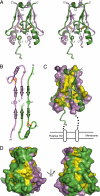Crystal structure of human mitoNEET reveals distinct groups of iron sulfur proteins
- PMID: 17766439
- PMCID: PMC1976232
- DOI: 10.1073/pnas.0702426104
Crystal structure of human mitoNEET reveals distinct groups of iron sulfur proteins
Abstract
MitoNEET is a protein of unknown function present in the mitochondrial membrane that was recently shown to bind specifically the antidiabetic drug pioglizatone. Here, we report the crystal structure of the soluble domain (residues 32-108) of human mitoNEET at 1.8-A resolution. The structure reveals an intertwined homodimer, and each subunit was observed to bind a [2Fe-2S] cluster. The [2Fe-2S] ligation pattern of three cysteines and one histidine differs from the known pattern of four cysteines in most cases or two cysteines and two histidines as observed in Rieske proteins. The [2Fe-2S] cluster is packed in a modular structure formed by 17 consecutive residues. The cluster-binding motif is conserved in at least seven distinct groups of proteins from bacteria, archaea, and eukaryotes, which show a consensus sequence of (hb)-C-X(1)-C-X(2)-(S/T)-X(3)-P-(hb)-C-D-X(2)-H, where hb represents a hydrophobic residue; we term this a CCCH-type [2Fe-2S] binding motif. The nine conserved residues in the motif contribute to iron ligation and structure stabilization. UV-visible absorption spectra indicated that mitoNEET can exist in oxidized and reduced states. Our study suggests an electron transfer function for mitoNEET and for other proteins containing the CCCH motif.
Conflict of interest statement
The authors declare no conflict of interest.
Figures




References
-
- Leahy JL. Arch Med Res. 2005;36:197–209. - PubMed
-
- Yki-Jarvinen H. N EnglJ Med. 2004;351:1106–1118. - PubMed
-
- Furnsinn C, Waldhausl W. Diabetologia. 2002;45:1211–1223. - PubMed
-
- Feinstein DL, Spagnolo A, Akar C, Weinberg G, Murphy P, Gavrilyuk V, Dello Russo C. Biochem Pharmacol. 2005;70:177–188. - PubMed
Publication types
MeSH terms
Substances
Associated data
- Actions
LinkOut - more resources
Full Text Sources
Other Literature Sources
Molecular Biology Databases

